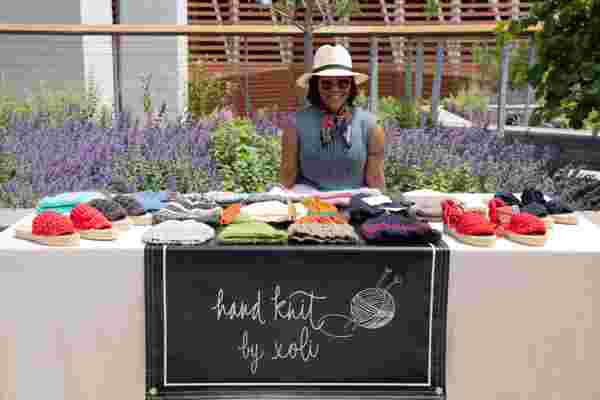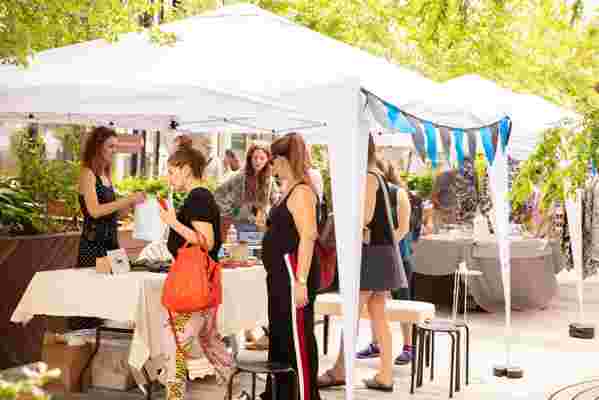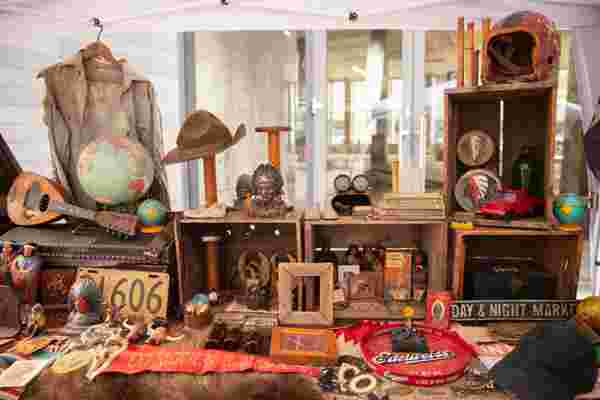In the terraced courtyard of Williamsburg’s William Vale, the 21-story, Albo Liberis–designed hotel that refashioned Brooklyn’s skyline when it opened in 2016, Phoenicia Flea founder James Anthony surveys his flock of makers and their goods: Turkish towels from Harlem's Home & Loft, artisan furniture from Brooklyn’s Untitled_Co, barrel-aged whiskey and gin from Vermont’s Stonecutter Spirits. It’s the Catskills-based nomadic Flea’s fifth year in business, but through the end of the year, Anthony’s usual route around New York state's Hudson Valley and the Catskills has expanded to include monthly appearances at the William Vale along with stops in Asbury Park, New Jersey; Westport, Connecticut; and the Berkshires in western Massachusetts. “Our whole philosophy is about marrying the local community with the guest experience,” says Anthony. “Making shopping social is what we’re about.”

Xoli Ngcoza of Connecticut-based Handknit by Xoli.
It’s a sort of retro view in an era of e-commerce—but that, says Anthony, is the whole point. He launched the Flea in 2014 while working as GM at The Graham & Co., the indie hotel darling in the town of Phoenicia, New York, that first began drawing Brooklynites to the Catskills. After three events held at the hotel, he took the show on the road, so to speak, suspecting that the nomadic approach would be better for both the creative and the financial bottom lines. “Despite what you might think, people do still prefer the conversation over just clicking-and-buying,” he says. “It’s a way for these artists to generate income they might not otherwise be able to do—a painter can sell a bunch of pieces in a weekend and not have to deal with the gallery circuit—but it’s also a lab for their work. Often, the people my artists meet at the Flea are the only live customers they ever encounter.”

More than 25 rotating makers fill the outdoor spaces around the William Vale.
The nomadic flea has proven to be a sustainable business model in an increasingly crowded makers’ market market that includes competitors like FAD Market and the bicoastal Artists & Fleas . Anthony says that keeping vendor fees low by fostering partnerships—like that with the William Vale —helps encourage loyal artisans willing to travel while also helping bolster business for creatives who aren’t always the most adept at the business end of things. He now puts on 20 events a year featuring a rotating cast of 300 small-batch vendors, hand-chosen for their taste level, good attitude, and team spirit. “My process is simple,” he says. “I look at what they do and it’s a 'yes' or a 'no.' I just want the experience to be fun for our vendors as well as for our guests.” (For this reason, most Phoenicia stops feature at least one “boozy vendor,” which Anthony always positions, enticingly, on the Flea’s perimeter.)

Mountaindale, New York–based vintage dealer State Land Supply Co.
This winter, he’ll take the operation westward, launching the Mojave Flea, headquartered in Palm Springs with designated stops throughout California and the Southwest. “The Coachella Valley is like the desert version of the Catskills,” he says. “We have tons of creatives and makers.” The category he’s most excited about is what he calls wellness and healer-based beauty. “I’ve got these witchy girls who do reiki and read cards and sell crystal-infused household cleaners potions and deodorants and really amazing serums and teas,” he says. “Any insight into the chaotic world we live in, goods handmade with thoughtfulness and intention…that’s really the experience I’m after—that I think we’re all after.”
RELATED: 6 Unexpected (and Inexpensive!) Things You Should Always Look For at a Flea Market
